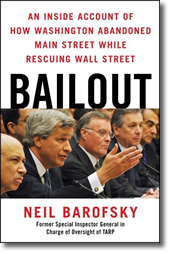Book Review: Bailout

Barofsky, Neil M. Bailout : an inside account of how Washington abandoned main street while rescuing Wall Street. Free Press, 2012.
Writing book reviews can be depressing. I am not referring to the isolation or self-doubt that plagues any writer. I am talking about the subject matter of many new books — today’s global economic situation.
Over 20 books reviewed or annotated in this blog cover the spectrum of this meltdown, what happened, why it happened and what should be done to prevent it from happening again. These new books include analysis by financiers Henry Paulson and George Soros, as well as economists Joseph Stiglitz and Nouriel Roubini. Books about Lehman Brothers, Ameriquest, AIG, Fannie Mae, Merrill Lynch and Bank of America are infuriating and sad, as are personal stories by journalists bankrupted by the mortgage crisis or by cutbacks on Wall Street. But reading Bailout, which details exactly how change happens (or not) in Washington, is deeply disturbing.
When Bailout begins, Neil Barofsky is a respected prosecutor in the U.S. Attorney’s Office investigating mortgage and securities fraud. In 2008, Barofsky is recruited by the White House as the special inspector general in charge of oversight of TARP funds, heading an office known as SIGTARP. His new job is to hold the U.S. Treasury and the banks it had bailed out accountable for the use of $700 billion of taxpayer funding in TARP. It is well known that in the global crisis, executives on Wall Street had exploited a financial system that guaranteed huge profits and pay regardless of risk because the U.S. taxpayer would cover the losses. But Barofsky also explains that government officials running the bailout program came from those same financial institutions and ensured that the bailout funds would benefit those same executives and firms.
When TARP was proposed, the funds were slated to buy troubled mortgages and bonds, which would stabilize the banks and allow the Treasury to modify the terms of the loans to give relief to homeowners in foreclosure. But the legislation was written loosely and instead of helping homeowners or the housing market, the funds were used to provide direct injections to the banks, which was quite lucrative to the executives who caused the crisis in the first place. Instead of using the funds for increased lending to stimulate the economy, the banks used the funds to buy securities and other banks, for salaries and bonuses, and for improving their balance sheets.
When Barofsky moves from New York City to Washington DC in 2008, he finds himself in a new world, where power and appearances mean everything. He writes frankly about the Washington powerful, especially Tim Geithner and others from the Treasury Department, who obstruct his efforts to institute fraud protections and to investigate mismanagement of TARP funds. By the time Barofsky leaves his position in 2011, TARP has ultimately resulted in larger banks, increasing the risk of another economic crisis. Little help is offered to struggling homeowners or the housing industry. He senses disillusionment among the public and encourages taxpayers to revolt against the government for taking their money and distributing it to banks without holding them accountable. This is an informative book about a complicated subject that is engrossing and personal. Recommended.
© Reviewer: Meg Trauner & Ford Library – Fuqua School of Business.
All rights reserved.